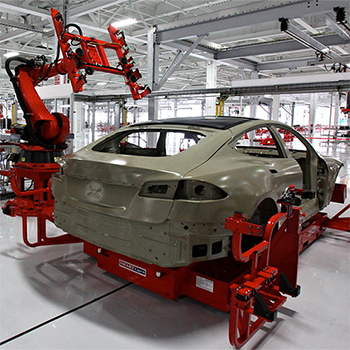Report Finds Injury Rates at Tesla’s Auto Factory Higher than Industry Average

A new report obtained by "CBS This Morning" shows the number of recordable injuries in 2015 at Tesla's factory in Fremont, California, was 31 percent higher than the industry average, and the rate of serious injuries was about double the industry rate.
Tesla Worker Safety
Worker safety at Tesla’s flagship auto plant has been called into question again - this time in a report that analyzes three years of federal records - as the US automaker tries to fend off attempts at unionization and undergoes a rapid expansion to produce the Model 3, an electric vehicle for the masses.
Worksafe, a worker safety advocacy group found injury rates at the plant were well above the industry average in 2014 and 2015, according to its independent review of work-related injuries and illnesses at Tesla’s Fremont, California plant.
Worksafe, which analyzed reports filed with the US Labor Department’s Occupational Safety and Health Administration, found similarly high injury rates in 2016 at the plant but is unable to offer an accurate comparison because official industry-wide statistics are not yet available for that year.
The Worksafe report not only outlines an array of worrisome data of Tesla’s past, it also questions whether the company’s recent claims of improved safety are accurate or believable.
Among the highlights at the Fremont factory that employs 10,000 workers:
Injury rates were 31 percent higher than the US industry average in 2015, with a total recordable incidence rate of 8.8 per 100 workers compared with 6.7 per 100.
Tesla’s total injury rate for 2016 was 8.1 injuries per 100 workers. (Industry stats for 2016 are not yet available, but if they remain at about 6.7 it would still put Tesla well beyond the average.)
The DART rate at Tesla in 2015 - a metric that means days away, restricted duty, or transfer rate - was double the industry rate in 2015. The DART rate identifies the number of days a worker is absent and is considered an indicator of the most serious nonfatal injuries.
Meanwhile, Tesla is trying to direct attention to its progress.
Read: Tesla's HR Head is Out Amidst Complaints Over Discrimination and Unsafe Working Conditions
“We may have had some challenges in the past as we were learning how to become a car company, but what matters is the future and with the changes we’ve made, we now have the lowest injury rate in the industry by far,” a Tesla spokesman said in an emailed statement.
“Our goal is to have as close to zero injuries as humanly possible and to become the safest factory in the auto industry.”
The data analyzed and reported by Worksafe suggests Tesla has a long way to go before it will achieve that goal. The report also questions the company’s recent claims of lowering injury rates at the factory.
Tesla published a blog in May highlighting improvements to its safety record and warning that the latest phase of UAW’s campaign to organize workers “involves a concerted and professional media push intended to raise questions about safety at Tesla.”
The blog boasted that the factory’s injury rates were 4.6 injuries per 100 workers through the first quarter of 2017 - 32 percent better than the industry average of 6.7.
Worksafe argues that one quarter isn’t a sufficient length of time to accurately determine whether this is a trend or a temporary dip that might have been helped by a one-week closure of the factory for maintenance. Worksafe also contends that company’s claims are based on preliminary data that can’t be considered accurate “given Tesla’s erratic reporting patterns.”
Tesla has vigorously defended its safety record in recent months, pushing back against claims that ambitious production goals have created an unsafe work environment.
Despite Tesla’s efforts, reports of worker safety issues have energized efforts to unionize the factory.
Related Article: Lasting Effects of Supply Chain Mismanagement
Related White Papers
2014-2017 Analysis of Tesla Injury Rates
Workers at Tesla became increasingly aware of the potential safety hazards at the company’s flagship vehicle plant in Fremont, California, and in April, workers first requested copies of the OSHA Form 300, the log of work-related injuries and illnesses that companies are required by law to make available to their employees. Download Now!
Why Risk Management Needs to Be a Key Initiative
Contractor verification is a win-win process for both you and the contractors you employee, and it’s essential in effective supply chain risk management. Download Now!
Four Steps to Building a Global Chain Risk Management Platform
In this white paper from Avetta, you’ll learn the keys to successfully managing your supply chain, protecting it against avoidable situations, and recovering from unforeseen disasters. Download Now!
More SC24/7: Risk Management White Papers
Article Topics
Avetta News & Resources
Compliance Risk: A Significant Impediment to the Modern Supply Chain Protecting Supply Chains Against Economic Uncertainty Supplier Classification: A Differentiator in the Modern Supply Chain Landscape New Cybersecurity Requirements Needed for Supply Chains Building End-to-End Risk Resiliency in Supply Chains Supply Chain 2030: Evolving Challenges, Opportunities and Technological Possibilities Extending ESG Best Practices Into the Supply Chain More AvettaLatest in Supply Chain
Spotlight Startup: Cart.com Walmart and Swisslog Expand Partnership with New Texas Facility Nissan Channels Tesla With Its Latest Manufacturing Process Taking Stock of Today’s Robotics Market and What the Future Holds U.S. Manufacturing Gains Momentum After Another Strong Month Biden Gives Samsung $6.4 Billion For Texas Semiconductor Plants Apple Overtaken as World’s Largest Phone Seller More Supply Chain


















